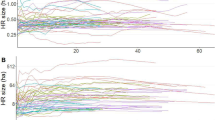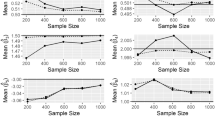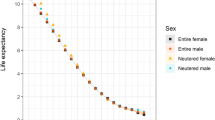Abstract
Populations of free-ranging dogs are still a matter of concern in developing countries. The presence of stray dogs is associated with environmental and public health consequences such as the spread of zoonotic diseases. Therefore, public health managers base the promotion of public health on sanitary measures, including the control of the free-ranging dogs’ population. In this context, it is necessary to evaluate the free-ranging dogs’ life dynamics, taking into account all characteristics of the data, including long-term survival. In long-term studies, some causes of censoring are generally falsely assumed to be independent, leading to bias neglected. Therefore, we propose a likelihood-based approach for long-term clustered survival data, which is suitable to accommodate the dependent censoring. The association between lifetimes and dependent censoring is accommodated through the conditional approach of the frailty models. The marginal distributions can be adjusted assuming Weibull or piecewise exponential distributions, respectively. A Monte Carlo Expectation–Maximization algorithm is developed to estimate the proposed estimators. The simulation study results show a small relative bias and coverage probability near to the nominal level, indicating that the proposed approach works well. Moreover, the model identifiability is assured once data has a cluster structure. Finally, we analyze the survival times of free-ranging dogs from the West Bengal, India, collected between 2010 to 2015, and conclude that survival time (death due to natural cause) is negatively correlated to dependent censoring (missing cause).


Similar content being viewed by others
References
Beaver BV (2009) Canine social behavior. Canine behavior, 2nd edn. Elsevier, Saint Louis, pp 133–192
Belo VS, Struchiner CJ, Werneck GL, Teixeira Neto RG, Tonelli GB, de Carvalho Júnior CG, Ribeiro RAN, da Silva ES (2017) Abundance, survival, recruitment and effectiveness of sterilization of free-roaming dogs: a capture and recapture study in Brazil. PLoS ONE 12:e0187233
Belo VS, Werneck GL, da Silva ES, Barbosa DS, Struchiner CJ (2015) Population estimation methods for free-ranging dogs: a systematic review. PLoS ONE 10:e0144830
Berkson J, Gage RP (1952) Survival curve for cancer patients following treatment. J Am Stat Assoc 47:501–515
Bernhardt PW (2016) A flexible cure rate model with dependent censoring and a known cure threshold. Stat Med 35:4607–4623
Boag JW (1949) Maximum likelihood estimates of the proportion of patients cured by cancer therapy. J R Stat Soc B11:15–53
Calsavara VF, Tomazella VL, Fogo JC (2013) The effect of frailty term in the standard mixture model. Chil J Stat 4:95–109
Cancho VG, Macera MA, Suzuki AK, Louzada F, Zavaleta KE (2020) A new long-term survival model with dispersion induced by discrete frailty. Lifetime Data Anal 26:221–244
Cancho VG, Rodrigues J, Castro MD (2011) A flexible model for survival data with a cure rate: a bayesian approach. J Appl Stat 38:57–70
Castro MD, Cancho VG, Rodrigues J (2009) A bayesian long-term survival model parametrized in the cured fraction. Biom J 51:443–455
Chaves JDS, Rodrigues J (2011) Standard exponential cure rate model with noninformative or informative uniform-exponential censoring. Commun Stat Simul Comput 40:364–382
Chen C-M, Lu T-FC, Chen M-H, Hsu C-M (2012) Semiparametric transformation models for current status data with informative censoring. Biom J 54:641–656
Chen M-H, Harrington DP, Ibrahim JG (2002) Bayesian cure rate models for malignant melanoma: a case-study of eastern cooperative oncology group trial e1690. J R Stat Soc C51:135–150
Chen M-H, Ibrahim JG, Sinha D (1999) A new bayesian model for survival data with a surviving fraction. J Am Stat Assoc 94:909–919
Czupryna AM, Brown JS, Bigambo MA, Whelan CJ, Mehta SD, Santymire RM, Lankester FJ, Faust LJ (2016) Ecology and demography of free-roaming domestic dogs in rural villages near Serengeti national park in Tanzania. PLoS ONE 11:e0167092
Dalla Villa P, Kahn S, Stuardo L, Iannetti L, Di Nardo A, Serpell J (2010) Free-roaming dog control among OIE-member countries. Prev Vet Med 97:58–63
Day MJ, Breitschwerdt E, Cleaveland S, Karkare U, Khanna C, Kirpensteijn J, Kuiken T, Lappin MR, McQuiston J, Mumford E et al (2012) Surveillance of zoonotic infectious disease transmitted by small companion animals. Emerg Infect Dis 18:e1
Demarqui FN, Dey DK, Loschi RH, Colosimo EA (2014) Fully semiparametric bayesian approach for modeling survival data with cure fraction. Biom J 56:198–218
Dempster AP, Laird NM, Rubin DB (1977) Maximum likelihood from incomplete data via the EM algorithm. J R Stat Soc B39:1–38
Diao G, Yin G (2012) A general transformation class of semiparametric cure rate frailty models. Ann Inst Stat Math 64:959–989
Dunson DB, Dinse GE (2002) Bayesian models for multivariate current status data with informative censoring. Biometrics 58:79–88
Emura T, Chen Y-H (2018) Analysis of survival data with dependent censoring: copula-based approaches. Springer, New York
Emura T, Nakatochi M, Murotani K, Rondeau V (2017) A joint frailty-copula model between tumour progression and death for meta-analysis. Stat Methods Med Res 26:2649–2666 (PMID: 26384516)
Farewell VT (1977) A model for a binary variable with time-censored observations. Biometrika 64:43–46
Freitas LA, Rodrigues J (2013) Standard exponential cure rate model with informative censoring. Commun Stat-Simul Comput 42:8–23
Gorfine M, Hsu L (2011) Frailty-based competing risks model for multivariate survival data. Biometrics 67:415–426
Guilloux AG, Panachão LI, Alves AJ, Zetun CB, Cassenote AJ, Dias RA (2018) Stray dogs in urban fragments: relation between population’s perception of their presence and socio-demographic factors. Pesquisa Veterinária Brasileira 38:89–93
Hougaard P (1995) Frailty models for survival data. Lifetime Data Anal 1:255–273
Huang X, Wolfe RA (2002) A frailty model for informative censoring. Biometrics 58:510–520
Ibrahim JG, Chen M-H, Sinha D (2001) Bayesian semiparametric models for survival data with a cure fraction. Biometrics 57:383–388
International W (2022) Global Dog Campaign a WellBeing International initiative. https://wellbeingintl.org/global-dog-campaign/about-gdc. Accessed 15 Mar 2022
Kalbfleisch JD, Prentice RL (2011) The Statistical analysis of failure time data. Wiley, Hoboken
Kim S, Chen M-H, Dey DK, Gamerman D (2007) Bayesian dynamic models for survival data with a cure fraction. Lifetime Data Anal 13:17–35
Knobel DL, Cleaveland S, Coleman PG, Fèvre EM, Meltzer MI, Miranda MEG, Shaw A, Zinsstag J, Meslin F-X (2005) Re-evaluating the burden of rabies in Africa and Asia. Bull World Health Organ 83:360–368
Kuk AY, Chen C-H (1992) A mixture model combining logistic regression with proportional hazards regression. Biometrika 79:531–541
Li Y, Tiwari RC, Guha S (2007) Mixture cure survival models with dependent censoring. J R Stat Soc 69:285–306
Liu Y, Hu T, Sun J (2017) Regression analysis of current status data in the presence of a cured subgroup and dependent censoring. Lifetime Data Anal 23:626–650
López-Cheda A, Jácome MA, López-de Ullibarri I (2021) npcure: an r package for nonparametric inference in mixture cure models. R J 13:21–41
Louis TA (1982) Finding the observed information matrix when using the EM algorithm. J R Stat Soc B44:226–233
Maller RA, Zhou S (1992) Estimating the proportion of immunes in a censored sample. Biometrika 79:731–739
Maller RA, Zhou X (1996) Survival analysis with long-term survivors. Wiley, Hoboken
Othus M, Li Y, Tiwari RC (2009) A class of semiparametric mixture cure survival models with dependent censoring. J Am Stat Assoc 104:1241–1250
Pal SK (2008) Maturation and development of social behaviour during early ontogeny in free-ranging dog puppies in West Bengal, India. Appl Anim Behav Sci 111:95–107
Paul M, Majumder SS, Sau S, Nandi AK, Bhadra A (2016) High early life mortality in free-ranging dogs is largely influenced by humans. Sci Rep 6:1–8
Rodrigues J, Cancho VG, de Castro M, Louzada-Neto F (2009) On the unification of long-term survival models. Stat Probab Lett 79:753–759
Schneider S, Demarqui FN, Colosimo EA, Mayrink VD (2020) An approach to model clustered survival data with dependent censoring. Biom J 62:157–174
Sinha D, Chen M-H, Ibrahim JG (2003) Bayesian inference for survival data with a surviving fraction. Lecture Notes-Monogr Ser 43:117–138
Smith LM, Hartmann S, Munteanu AM, Dalla Villa P, Quinnell RJ, Collins LM (2019) The effectiveness of dog population management: a systematic review. Animals 9:1020
Staplin N, Kimber A, Collett D, Roderick P (2015) Dependent censoring in piecewise exponential survival models. Stat Methods Med Res 24:325–341
Tawiah R, McLachlan GJ, Ng SK (2020) A bivariate joint frailty model with mixture framework for survival analysis of recurrent events with dependent censoring and cure fraction. Biometrics 76:753–766
Taylor JM (1995) Semi-parametric estimation in failure time mixture models. Biometrics 51:899–907
Totton SC, Wandeler AI, Zinsstag J, Bauch CT, Ribble CS, Rosatte RC, McEwen SA (2010) Stray dog population demographics in Jodhpur, India following a population control/rabies vaccination program. Prev Vet Med 97:51–57
Tsiatis A (1975) A nonidentifiability aspect of the problem of competing risks. Proc Natl Acad Sci USA 72:20–22
Vanak AT, Gompper ME (2010) Interference competition at the landscape level: the effect of free-ranging dogs on a native mesocarnivore. J Appl Ecol 47:1225–1232
Wang S, Wang C, Sun J (2021) An additive hazards cure model with informative interval censoring. Lifetime Data Anal 27:244–268
Ward C, Bauer EB, Smuts BB (2008) Partner preferences and asymmetries in social play among domestic dog, Canis lupus familiaris, littermates. Anim Behav 76:1187–1199
Wei GC, Tanner MA (1990) A Monte Carlo implementation of the EM algorithm and the poor man’s data augmentation algorithms. J Am Stat Assoc 85:699–704
Wienke A (2011) Frailty models in survival analysis. Biostatistics series. CRC Press, Boca Raton
Yakovlev AY, Asselain B, Bardou V, Fourquet A, Hoang T, Rochefediere A, Tsodikov A (1993) A simple stochastic model of tumor recurrence and its application to data on premenopausal breast cancer. Biometrie et analyse de donnees spatio-temporelles 12:66–82
Yee TW (2010) The vgam package for categorical data analysis. J Stat Softw 32:1–34
Yin G, Ibrahim JG (2005) A general class of bayesian survival models with zero and nonzero cure fractions. Biometrics 61:403–412
Yu B, Tiwari RC, Cronin KA, Feuer EJ (2004) Cure fraction estimation from the mixture cure models for grouped survival data. Stat Med 23:1733–1747
Author information
Authors and Affiliations
Corresponding author
Additional information
Communicated by Luiz Duczmal.
Appendices
Appendix A: Approximate information matrix
Given the frailty terms \(w_{i}, i=1,\cdots ,m\), the conditional likelihood function for the complete data \(({\mathbf {d}}, {\mathbf {w}})\), where \({\mathbf {d}}\) denotes the observed data and \({\mathbf {w}}\) the unobserved frailty, is the following:
where \({\mathbf {d}}_{ij}=( y_{ij},~ \delta ^{(T)}_{ij},~ \delta ^{(C)}_{ij}, ~ {\mathbf {x}}^{(T)}_{ij}, ~ {\mathbf {x}}^{(C)}_{ij})'\) corresponds to the observed data, for \(i=1, \cdots , m\) and \(j=1, \cdots , n_{i}\); \(\varvec{\Theta }^{(T)}=\left( \varvec{\psi }^{(Z)}, \varvec{\beta }^{(T)}\right) \) and \(\varvec{\Theta }^{(C)}=\left( \varvec{\psi }^{(C)}, \varvec{\beta }^{(C)},\phi \right) \), with \(\varvec{\psi }^{(Z)}\) and \(\varvec{\psi }^{(C)}\) being vectors of parameters associated with the baseline distributions of the promotion times Z and the dropout times, respectively; \(\varvec{\beta }^{(T)}\) and \(\varvec{\beta }^{(C)}\) are \(p \times 1\) and \(q \times 1\) vectors of regression coefficients related to \({\mathbf {x}}_{ij}^{(T)}\) and \({\mathbf {x}}_{ij}^{(C)}\); \(w_{i}\) is the frailty term for the ith cluster; and \(\phi \) is the association parameter.
1.1 A.1 Weibull cure model with dependent censoring
Consider the Weibull model with cure rate proposed in Section 2.2, the parameter vector is denoted by \(\varvec{\Theta }= \left( \varvec{\Theta }^{(T)}, \varvec{\Theta }^{(C)}, \phi , \sigma ^{2}\right) \), where \(\varvec{\Theta }^{(T)}=\left( \varvec{\psi }^{(Z)}, \varvec{\beta }^{(T)}\right) \) and \(\varvec{\Theta }^{(C)}=\left( \varvec{\psi }^{(C)}, \varvec{\beta }^{(C)}\right) \), with \(\varvec{\psi }^{(Z)} = (\alpha ^{(Z)}, \gamma ^{(Z)})\) and \(\varvec{\psi }^{(C)} = (\alpha ^{(C)}, \gamma ^{(C)})\).
The first-order partial derivatives are given by
and
The second-order partial derivatives are given by
and
The other elements of the matrix are null.
1.2 A.2 Piecewise exponential cure model with dependent censoring
Consider the piecewise exponential model with cure rate proposed in Sect. 2.3, the parameter vector is denoted by \(\varvec{\Theta }= \left( \varvec{\Theta }^{(T)}, \varvec{\Theta }^{(C)}, \phi , \sigma ^{2}\right) \), where \(\varvec{\Theta }^{(T)}\!\!=\left( \varvec{\psi }^{(Z)}, \varvec{\beta }^{(T)}\right) \!\!\) and \(\varvec{\Theta }^{(C)}=\left( \varvec{\psi }^{(C)}, \varvec{\beta }^{(C)}\right) \), with \(\varvec{\psi }^{(Z)}\!\!=\!\!\left( \lambda _{1}^{(Z)}, \cdots , \lambda _{b_{Z}}^{(Z)}\right) \) and \(\varvec{\psi }^{(C)}=\left( \lambda _{1}^{(C)}, \cdots , \lambda _{b_{C}}^{(C)}\right) \) are vectors of failure rates, with \(\lambda ^{(Z)}_{k}>0\) and \(\lambda ^{(C)}_{l}>0\), for \(k = 1, \cdots , b_{(Z)}\) and \(l = 1, \cdots , b_{(C)}\).
The first-order partial derivatives are given by
and
The second-order partial derivatives are given by
The other elements of the matrix are null.
Appendix B: Simulation studies
In this Section we present the results for the adjustments with 3 and 7 intervals in the exponential piecewise model (Table 7). In addition, we evaluated the impact of the frailty distribution, Table 8, and the variation in the number of individuals per cluster (Table 9).Figure 3 shows the 500 means of the ratios \(RB^{indep} /RB^{dep}\), for the scenario with positive correlation and Weibull adjustment.
Distribution of the 500 means of the ratio \(\text {RB}^{indep}/\text {RB}^{dep}\) calculated as in the Eq. (14)
To assess the impact of the frailty distribution misspecification, we performed a simulation study considering 500 datasets for each scenario (positive correlation (\(\phi =2\)), negative correlation (\(\phi =-2\)), and independence (\(\phi =0\))). The frailty terms were generated from a log-gamma distribution wich parameters location = 0, scale = 1, and shape = 1.4 (resulting in mean\(\approx \) 0 and variance \(\approx \) 1) from the VGAM R package (Yee 2010). The adjustment was performed using the proposed Weibull model and the standard Weibull model (assuming independence between T and C), and the results can be found in Table 8 of the Appendix. Even if the frailty distribution is incorrectly specified, we can observe that the proposed approach performs well. In general, all regression coefficients have a relative bias less than 5%, standard deviation close to standard errors, coverage probability close to nominal value, except for the parameter \(\sigma ^2\), which is expected since the frailty distribution is misspecified.
Rights and permissions
Springer Nature or its licensor holds exclusive rights to this article under a publishing agreement with the author(s) or other rightsholder(s); author self-archiving of the accepted manuscript version of this article is solely governed by the terms of such publishing agreement and applicable law.
About this article
Cite this article
Schneider, S., Demarqui, F. & de Freitas Costa, E. Free-ranging dogs’ lifetime estimated by an approach for long-term survival data with dependent censoring. Environ Ecol Stat 29, 869–911 (2022). https://doi.org/10.1007/s10651-022-00549-0
Received:
Revised:
Accepted:
Published:
Issue Date:
DOI: https://doi.org/10.1007/s10651-022-00549-0





